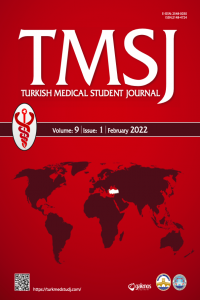EVALUATION OF PHYSICAL EXERCISE'S EFFECTS ON LOW BACK PAIN AMONG UNIVERSITY STUDENTS WITH SHORT FORM-36 AND OSWESTRY DISABILITY INDEX
EVALUATION OF PHYSICAL EXERCISE'S EFFECTS ON LOW BACK PAIN AMONG UNIVERSITY STUDENTS WITH SHORT FORM-36 AND OSWESTRY DISABILITY INDEX
Low back pain, physical exercise, Body Mass Index, Short Form-36, Oswestry Disability Index,
___
- 1. Gökmen FG, Ertürk M. Hareket Sistemi/Kemikler. Sistematik Anatomi. İzmir: Güven Kitabevi; 2003.
- 2. Hoy D, March L, Brooks P et al. The global burden of low back pain: estimates from the global burden of disease 2010 study. Ann Rheum Dis 2014;73(6):968-74.
- 3. Lidgren L. The bone and joint decade 2000-2010. Bull World He- alth Organ 2003;81(9):629.
- 4. Özcan Yıldız E. Bel Ağrısı. Fiziksel Tıp ve Rehabilitasyon. Ankara: Güneş Kitabevi; 2000.
- 5. Hayes MJ, Smith DR, Cockrell D. Prevalence and correlates of mus- culoskeletal disorders among Australian dental hygiene students. Int J Dent Hyg 2009;7:176 – 81.
- 6. Alshagga MA, Nimer AR, Yan LP et al. Prevalence and factors associated with neck, shoulder and low back pains among medical students in a Malaysian Medical College. BMC Res Notes 2013;6:244.
- 7. Stamm TA, Pieber K, Crevenna R et al. Impairment in the acti- vities of daily living in older adults with and without osteoporosis, osteoarthritis and chronic back pain: a secondary analysis of popu- lation-based health survey data. BMC Musculoskeletal Disorders 2016;17(1):139.
- 8. Thelin A, Holmberg S, Thelin N. Functioning in the neck and low back pain from a 12-year perspective: a prospective population-ba- sed study. Journal of Rehabilitation Medicine 2008;40(7):555–61.
- 9. Dieleman JL, Baral R, Birger M et al. US spending on personal he- alth care and public health 1996-2013. JAMA 2016;316(24):2627–46.
- 10. Vujcic I, Stojilovic N, Dubljanin E et al. Low Back Pain among medical students in Belgrade (Serbia): a cross-sectional study. Pain Res Manag 2018;6:8317906.
- 11. Croft P, Altman DG, Deeks JJ et al. The science of clinical practise: disease diagnosis or patient prognosis? Evidence about "what is likely to happen" should shape clinical practice. BMC Med 2015;(30):13.
- 12. Guralnik JM, Ferrucci L, Pieper CF et al. Lower extremity func- tion and subsequent disability: consistency across studies, predictive models, and value of gait speed alone compared with the short physi- cal performance battery. J Gerontol A Biol Sci Med Sci 2000;55:221– 31.
- 13. Ostir GV, Markides KS, Black SA et al. Lower body functioning as a predictor of subsequent disability among older Mexican Ameri- cans. J Gerontol A Biol Sci Med Sci 1998;53:491–5.
- 14. Andresen EM, Gravitt GW, Aydelotte ME et al. Limitations of the SF-36 in a sample of nursing home residents. Age and Ageing 1999;28:562–6.
- 15. Ware JE Jr, Gandek B. Overview of the SF-36 Health Survey and the International Quality of Life Assessment (IQOLA) Project. J Clin Epidemiol 1998;51:903–12.
- 16. Koçyiğit H, Aydemir O, Fişek G et al. Reliability and Validity of the Turkish Version of Short Form-36 (SF-36). İlaç ve Tedavi Dergisi 1999;12:102-6.
- 17. Yakut E, Düger T, Öksüz Ç et al. Validation of the Turkish versi- on of the Oswestry Disability Index for patients with low back pain. Spine 2004;29(5):581-5.
- 18. Fairbank JC, Couper J, Davies JB. The Oswestry Low Back Pain Questionnaire. Physiotherapy 1980;66:271-3.
- 19. Prescott-Clarke P, Primatesta P. Health Survey for England 1999. London;2000.
- 20. Ferrucci L, Guralnik JM, Studenski S et al. Designing randomi- zed, controlled trials aimed at preventing or delaying functional dec- line and disability in frail, older persons: a consensus report. J Am Geriatr Soc 2004;52:625–34.
- 21. Brazier JE, Harper R, Jones NM et al. Validating the SF-36 health survey questionnaire: new outcome measure for primary care. BMJ, 1992;305:160–4.
- 22. Tanaka M, Fukuda S, Mizuno K et al. Stress and coping styles are associated with severe fatigue in medical students, Behavioral Medi- cine 2009;35(3):87–92.
- 23. Guite JW, Logan DE, Sherry DD et al. Adolescent self-perception: associations with chronic musculoskeletal pain and functional disa- bility. J Pain 2007;8(5):379-86.
- 24. Moroder P, Runer A, Resch H et al. Low back pain among medical students. Acta Orthopaedica Belgica 2011;77(1):88-92.
- 25. Chen MK. The epidemiology of self-perceived fatigue among adults. Prev Med 1986;15:74-81.
- 26. Corfield EC, Martin NG, Nyholt DR. Co-occurrence and sympto- matology of fatigue and depression. Compr Psychiatry, 2016;71:1–10.
- 27. Amelot A, Mathon B, Haddad R et al. Low back pain among me- dical students. SPINE 2019;44(19):1390–5.
- 28. Muntaner-Mas A, Palou P, Ortega FP et al. Sports participation and low back pain in schoolchildren. Journal of Back and Musculos- keletal Rehabilitation 2018;1:1–9.
- ISSN: 2148-4724
- Başlangıç: 2014
- Yayıncı: Trakya Üniversitesi
THOUGHTS AND AWARENESS OF MEDICAL STUDENTS ABOUT THE COVID-19 PANDEMIC
Hilal Sena ÇİFCİBAŞI, Alperen ELİBOL, Berkay KEF, Bengisu GÜR, Selin KOLSUZ, Berra KURTOĞLU, Hasan Orkun İPSALALI, Nazlıcan KÜKÜRTCÜ, Ece ŞENYİĞİT, Ekin ALTINBAŞ, Berfin TAN, Aslı GÖZTEPE, Alperen Taha CERTEL, Arda Ulaş MUTLU, Burak BARDAKÇI, Elif CENGİZ, Nigar KELEŞ ÇELİK, Can ERZİK, Mehmet Ziya DO
KNOWLEDGE LEVEL OF MEDICAL, PHARMACY AND NURSING STUDENTS ABOUT VACCINATION AND VACCINE SAFETY
Ertuğrul KOÇAK, Aynur Sanem YILMAZ, Bilge Nur MUTLU, Fatma KAYNAK ONURDAĞ
CERVICAL MENINGOCELE IN A NEWBORN: A CASE REPORT
Eylül ŞENÖDEYİCİ, Ahmet Tolgay AKINCI, Yener AKTÜRK
Arda Ulaş MUTLU, Bilgesu AYDIN, Özge ECERTAŞTAN, Eren ÖĞÜT, Bilge GÜVENÇ TUNA, Hakan TUNA
CORONAVIRUS DISEASE-19 (COVID-19): THE DISEASE THAT CHANGED THE WORLD
Beliz KOÇYİĞİT, Sezin SAYIN, Fevzi Oktay ŞİŞMAN, Sarper KIZILKAYA, Mert Yücel AYRIK
POSSIBLE BENEFICIAL EFFECTS OF VITAMIN K AND OSTEOCALCIN ON GLUCOSE METABOLISM
Büşra BAŞPINAR, Nurcan YABANCI AYHAN
ASSESSMENT OF THE OPINIONS AND ATTITUDES OF MEDICAL STUDENTS TOWARDS LGBTQIA+ INDIVIDUALS
Fatih Erkan AKAY, Beliz KOÇYİĞİT, Amila KAFADAR, Beril AY, Kaan ÇİFCİBAŞI, Çağrı GİRİT, Nazlıcan KÜKÜRTCÜ, Berra KURTOĞLU, Bengisu GÜR, Serdar ÖZTRORA
